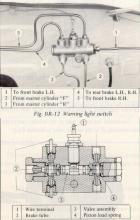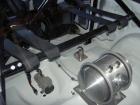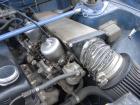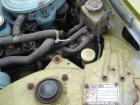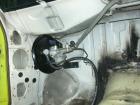The stock 1200 front-disc/rear-drum system was good for 1971. In fact, stopping power was better than most 'muscle cars' of the era. However, fading under repeated hard stops was a problem as these were not ventilated rotors. But compared to modern cars ... well, they don't really compare at all -- even the cheapest new import car has better brakes than the 1973 Datsun 1200.
There are two easy ways to get better brakes:
- Better brake pads, using premium materials
- Simple brakes swaps
This article will discuss these methods.
There is also a more complicated way, which allows you to have world-class brakes, as good as any new car. This is by swapping the struts with their brake assemblies. For details see Strut swaps
Contents |
Better Brake Pads
Better brake pads can make a big difference. If you are a racer you know this. But for a street car, if you live in a hilly or mountainous area and your brakes fade, consider new pads.
Spend the money and put something good in the coupe- Pagid or Mintex 1155's etc and if you can't get them to fit your caliper then put something else on that you can get a good quality pad for.And if anyone tells you that they are no good on the street thats simply not true - the new generation compounds work just fine from cold. Sure they get much better when hot, but are more than adequate for driving around the streets on.
reference: BENDIX ULTIMATE FRONT PADS
Brake Booster
Factory Brake Booster was used from October 1989 in Sunny Truck.
See main article: Brake Booster What follows is for swaps from other cars
Tip: Use Lancer LA/LB or B210 booster for easiest fit into a stock 1200. Details below.
With the light weight of the 1200, you don't need one (the pedal effort is not high on a 1200). Note that even on heavy cars, a booster doesn't make the brakes stop the car sooner, but only makes it easier to press the pedal. If your small brakes are locking up now, a booster will only make them lock up with less pressure on the pedal!
A booster will not improve the braking ability of the car. But if you want one so that it is a bit easier to press the brake pedal:
- B210 Brake Booster & cylinder, was fitted to many disc-brake B210s. In Australia, you can use a 120Y dual system master cylinder and a 180B (610) booster
- B310 (1979-1982) booster and master cylinder (13/16 inch). Need to modify firewall mounting point as these have four bolts
- You may need to modify (lengthen/shorten) the rod that comes out of the booster. Use a depth guage (bit of stick) and make sure that the booster rod sits nicely inside the master cylinder. The booster is exactly the same internals as the 180B booster. Any larger booster, and you've really got to start cutting into the strut tower. reference: Sunny brake booster
- 260Z master cylinder (7/8 in diameter)
- master and booster from a Toyota Celica on
a 1200. mareospeedwagon had to drill holes in the firewall to mount it but it worked real well.
- Mitsubishi/Chrysler Galant
Extra-long booster spacer:
Mitsubishi Lancer 1970-1980
The Mitsubishi LA or LB Lancer booster with its master cylinder is a straight bolt-in, though you may need to drill a slightly bigger hole in your brake pedal to fit the new pin through. It will fit next to a clutch master cylinder.
LA Lancer (1970-1976), also known as: * Chrysler Valiant Lancer (1973-1976)
LB Lancer (1977-1979) * Dodge Colt (earlier Colts were Galants) * Plymouth Arrow (coupe version)
- Photos showing install of Lancer Booster
- If you use a Datsun master cylinder with the Lancer booster, you may need to dent the strut tower in a little in order for the booster to fit.
-

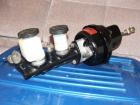
LA/LB Lancer brake booster bolts straight up to the firewall, and the brake pedal, all u need is to get some brake lines made up. It uses 2 holes to bolt to the fire wall by way of a factory aluminum adaptor bracket.
To use the Datsun master cylinder with a lancer booster, you probably have to do some machining work. The outside diameter of the Datsun part is slightly too big for the front of the Mitsubishi part. A friend of mine machined down the master cylinder, but now I'd get the Mitsubishi bit made to suit the master cylinder. The part I'm referring to is the alloy casting which bolts to the front of the booster, and that the master cylinder bolts onto.
reference: what brake booster is the best fit for a 1200
Remote Brake Booster
All-drum 1200
If your 1200 has all-drum brakes, take note that disc brakes are:
- easier to work on
- fairly easy to swap out the front drums for discs
- More resistant to fading -- safer after repeated stops (they dissapate heat far better)
Master Cylinder Choice
If you change to all front-discs, you can either use:
- disc-model master cylinder and brake-line "splitter" (warning light switch)
- The "tandem" cylinder is recommended (it has two reservoirs)
- IMPORTANT: Don't use a single outlet cylinder. It is less safe as all four brakes can fail at once. A double-outlet cylinder is safer
Brake Warning Switch
Don't forget to use a brake warning switch.
Remote Brake Cylinder
If you are fitting a larger engine or carbs so there is no room for the stock brake cylinder, consider a remote cylinder setup.
 no brake cylinder?
no brake cylinder?
Discussion: Wilwood Pedal Boxes has anyone fitted them to their 1200?
Remote Filler
Remote filler setup from circa 1976 Datsun F10
Underdash
Reverse-Mounted Master Cylinder
Fitting an under-dash brake master cylinder is sometimes done to LHD 1200s so we can fit dual sidedraft carbs. It is legal in USA (very few states have any kind of mechanical inspection).
As you can see, LHD cars have little room for both the brake cylinder (on left side of engine compartment) when bigger carbs are fitted:

Take a master cylinder mount from a 510 and weld it to the top of the 1200's steering colum support. Then weld an extension to the top of the brake pedal and makee a rod to connect the master cylinder from the brake pedal.
Changing the position of the rod from below pivot point to above changes the direction from pushing out toward front of car to pushing out towards rear.
280zx master cylinder reverse mounted under dash
- A remote fluid reservoir would be easiest (e.g. Datsun F10 style)
- It only take a minute to remove dash for access
Sometimes the same is done when fitting large engines or turbo setups which leave no room for the stock master cylinder.
For more ideas, see Clutch master cylinder
Brake Bias
So you've changed brake types, now has the front brakes are locking up well before the rears come into play. How can this be cured?
There are options for changing the brake bias:
- Change rear brake wheel cylinders (larger or smaller). Alternate sizes are available from Nissan motorsports. Or from stock applications. For example, the 510 rear cylinders are 7/8, but bolt in place of the stock 1200 13/16 cylinders. Note that 1200s with drum brakes already have 7/8 rears.
- Use an appropriate factory bias valve (aka NP-valve or "proportioning valve"). Note that Datsun 1200s don't use one, while B210 and B310 NP-valves are not part of the brake line "splitter" (brake line warning switch)
- Maybe the easiest would be to buy a brake bias controller valve.
- These are
available thru your local high performance shop or mail order thru Jeg's or Summit, etc. for around $50 USD.
- Some Volvos also have an adjustable valve you could use
'Changing master cylinders may change pedal feel but will not change bias. A master with larger diameter cylinder will result in a harder pedal, but less pedal travel. By contrast, a smaller diameter master cylinder will reduce required pedal foot pressure, but will increase pedal travel for a given result. Most Nissan master cylinders from the same era (1971-1982) interchange. You can locate almost any size with a cruise through your local junk yard (sizes are cast on
the side of the cylinder).
Note that B110s did not use a proportioning valve. B310 used one (called NP-Valve). The NP-valve is separate from the brake circuit switch (brake line splitter). It is functionally normally if -- during a 50km/h quick stop -- the rear the wheels lock simultaneously with front wheels, or front wheels lock first. Danger if rear wheels lock first.
| brake cylinders | B110 | 1977 US B210 | 1980 US B310 (Disc-AN20) | 1980 Canada A12A (Disc-AN18) |
| Proportioning valve | not used | yes | 1,961 kPa x 0.4 psi | 1,961 kPa x 0.4 psi |
| Booster (Master-Vac) | not used | ? | M60 6-in diameter 135mm rod length (flange-to-pedal) | M60 6-in diameter |
| Master diameter | 11/16 inch | 3/4 inch | 13/16 | 13/16 |
| Front cylinder diameter | 1.894 inch (drum brakes: 11/16) | 2.012 inch | 2.012 inch | 1.894 inch |
| Rotor diameter | 212.5 mm | 245mm | 245mm | 220mm |
| Pad (width x length) | 42.5 x 53.1 mm | 41.2 x 63.4 mm | 41.2 x 61.4 mm | 42.0 x 56.8 mm |
| Pad thickness | 10.3 | 10.0 | 10.0 | 10.3 |
| Total front braking area (discs) | 14.0 sq in | 16.2 sq in | ~14.6 | ~13.8 |
| Total front braking area (drums) | 42.3 sq in | n/a | n/a | n/a |
| Rear cylinder diameter | disc brake models: 11/16 inch (all-drum models: 13/16) | 13/16 inch | 13/16 | 13/16 |
| Drum diameter | 8.0 inch | 8.0 inch | 8.0 | 8.0 |
| Drum width | 1.378 inch | 1.378 inch | 1.378 | 1.378 |
| Total rear braking area | 42.3 sq in | 42.3 sq in | 42.3 | 42.3 |
|
Large Pad
|
Small Pad B110, B310 A12A Canada: Beck/Arnley 0820100 Premium Organic, Beck/Arnley "AXXIS Deluxe" Organic, RAYBESTOS PGD104 PG Plus Organic, ACDELCO 17D104 Durastop Organic, Wearever Silver D41, Bendix D104
- B110, 1973 - 1974 CIVIC, 1976 - 1978 Datsun F10, B310 Canada A12A

![[Datsun 1200 encyclopedia]](/wiki/upload/wiki.png)







